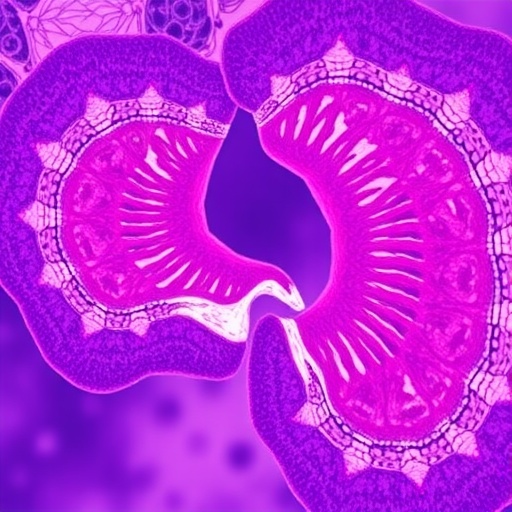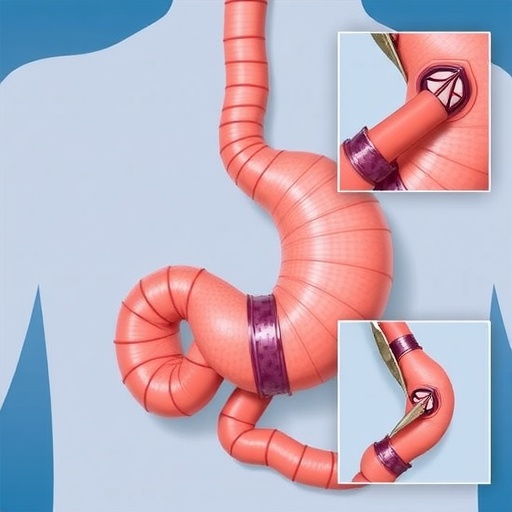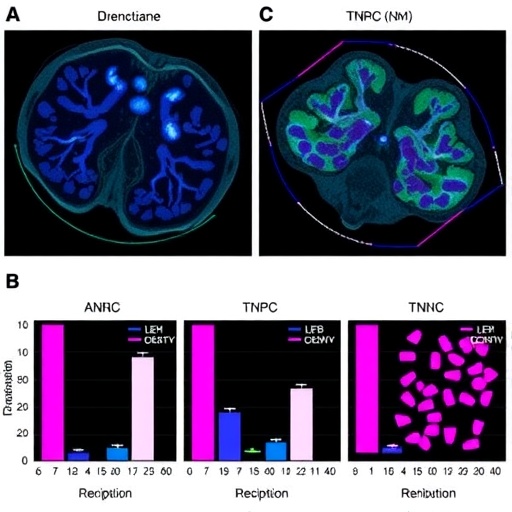In the ever-evolving landscape of cancer immunotherapy, one of the most formidable challenges remains the innate resistance some tumors exhibit against immune checkpoint inhibitors. Non-small cell lung cancer (NSCLC), which constitutes the majority of lung cancer cases worldwide, often presents with such resistance, sharply limiting the efficacy of treatments targeting the PD-1/PD-L1 axis. In a groundbreaking study, researchers have identified a critical molecular player—KIF20A—that drives resistance to anti-PD-1 therapy by modulating PD-L1 expression in NSCLC, opening new avenues for prognostic assessments and therapeutic interventions.
Immune checkpoint inhibitors have long been hailed as revolutionary in oncology, empowering the immune system to recognize and destroy cancer cells. Central to this mechanism is the PD-1 receptor on immune cells and its ligand PD-L1 on tumor cells. By blocking this interaction, anti-PD-1 drugs release the brakes on immune responses, promoting tumor eradication. Yet, a significant subset of NSCLC patients derives little benefit from such therapies, highlighting the urgent need to decode the molecular underpinnings of immunotherapy resistance.
KIF20A emerged from an integrative bioinformatics approach as a hub gene intricately linked with resistance phenotypes. Known primarily as a cell cycle regulator associated with chemotherapy resistance, KIF20A’s role in tumor immunity had remained elusive until now. Utilizing datasets from TCGA and GEO, the research team systematically pinpointed KIF20A’s aberrant overexpression in NSCLC tumors compared to adjacent normal tissues, a revelation that set the stage for deeper clinical inquiry.
The study’s clinical arm incorporated a cohort of 106 NSCLC patients undergoing anti-PD-1 treatment, with KIF20A expression quantified through rigorous immunohistochemical (IHC) analyses. The findings were compelling: over 63% of tumor samples exhibited high KIF20A protein levels versus a mere 13.2% in normal tissue counterparts. Moreover, elevated KIF20A correlated strongly with aggressive clinicopathological features including lymph node metastasis, poor differentiation, and advanced tumor stages, reinforcing its prognostic significance.
Delving into the tumor microenvironment (TME), the researchers deployed multiplex immunofluorescence (mIHC) to scrutinize PD-L1 expression patterns in tandem with KIF20A levels. A striking inverse relationship emerged—tumors with high KIF20A expression manifested significantly diminished densities of PD-L1-positive tumor cells. This downregulation of PD-L1 in KIF20A-overexpressing tumors suggests a sophisticated tumor adaptive mechanism, potentially undermining the tumor’s visibility to PD-1 targeted therapies and thus fueling primary resistance.
Survival analyses cemented the clinical implications of these molecular dynamics. Patients harboring tumors with high KIF20A expression experienced markedly shorter overall survival post-immunotherapy initiation. The hazard ratio of 3.40 indicates a more than threefold increased risk of mortality compared to patients with lower KIF20A expression, underscoring the biomarker’s powerful prognostic capability. Even more concerning was the synergistic effect observed in the subgroup with combined high KIF20A and low PD-L1 expression, where survival outcomes plummeted further, embodying a particularly resistant and aggressive tumor phenotype.
Mechanistically, the study advances the concept that KIF20A may drive anti-PD-1 resistance by actively repressing PD-L1 expression, thereby rendering immunotherapeutic blockade ineffective. This insight challenges the traditional understanding that PD-L1 presence is invariably a marker of immune evasion, revealing a complex interplay where its suppression can also underpin resistance through immune escape pathways yet to be fully elucidated.
From a therapeutic standpoint, KIF20A’s identification as a resistance driver holds tremendous promise. Targeting KIF20A directly or modulating its downstream effects could restore PD-L1 expression levels or circumvent PD-L1-independent escape mechanisms, thus sensitizing tumors to immune checkpoint blockade. Moreover, integrating KIF20A status into clinical decision-making may refine patient selection for immunotherapy, sparing non-responders from unwarranted side effects and guiding them towards alternative modalities.
The integration of advanced bioinformatics with meticulous clinical validation exemplifies the power of translational oncology research. By leveraging large-scale genomic datasets and sophisticated imaging modalities, the investigators have constructed a compelling narrative that bridges molecular biology with tangible clinical outcomes, enriching the collective understanding of NSCLC immunoresistance.
Beyond its immediate application, this study prompts a reevaluation of tumor immune evasion paradigms. The counterintuitive finding that PD-L1 downregulation via KIF20A elevates therapeutic resistance demands further scrutiny into the intricacies of the tumor-immune dialogue, potentially revealing novel checkpoints and escape mechanisms exploitable for treatment.
Future research trajectories may focus on dissecting the signaling networks connecting KIF20A to PD-L1 transcriptional and post-translational regulation, as well as exploring the broader impact of KIF20A on immune cell infiltrates within the tumor milieu. Such insights could unveil multifaceted strategies to dismantle the immunosuppressive fortress constructed by resistant tumors.
In essence, this seminal investigation not only identifies KIF20A as a pivotal molecule orchestrating resistance to anti-PD-1 therapy in NSCLC, but also positions it as a dual biomarker and therapeutic target. The KIF20A/PD-L1 signature provides a robust framework for risk stratification and personalized medicine, moving the needle closer to overcoming the immunotherapy resistance frontier that has long stalled progress in lung cancer treatment.
As immuno-oncology continues its rapid ascent, the revelation of KIF20A’s role represents a critical piece of the complex puzzle, offering hope for more durable responses and improved survival for patients grappling with NSCLC. Harnessing this knowledge could ultimately translate into next-generation therapies capable of outsmarting tumor escape strategies and achieving sustained remission.
The study’s multidisciplinary approach, encompassing computational analysis, pathological assessment, and survival modeling, showcases the future of cancer research—integrative, dynamic, and patient-centered. Its findings reinforce the imperative of personalized medicine and herald a new chapter in the battle against one of the deadliest malignancies known.
This fresh perspective on resistance mechanisms also highlights the necessity of continual biomarker discovery and validation in clinical cohorts to ensure that treatment paradigms evolve synchronous with emerging molecular insights. KIF20A stands out as a beacon in this endeavor, illuminating paths toward improved diagnostic accuracy and enhanced therapeutic precision.
In conclusion, the discovery of KIF20A’s capacity to drive anti-PD-1 resistance via PD-L1 downregulation in NSCLC enriches the scientific community’s understanding of tumor immune evasion and lays critical groundwork for innovative clinical applications. It exemplifies the profound impact that molecular characterization can exert on shaping the future of cancer therapeutics.
Subject of Research: The role of KIF20A in driving primary resistance to anti-PD-1 immunotherapy in non-small cell lung cancer (NSCLC) through modulation of PD-L1 expression and its implications for tumor microenvironment and patient prognosis.
Article Title: KIF20A as a driver of anti-PD-1 resistance via PD-L1 downregulation in NSCLC: a biomarker validation and tumor microenvironment analysis
Article References:
Su, T., Li, L., Jing, C. et al. KIF20A as a driver of anti-PD-1 resistance via PD-L1 downregulation in NSCLC: a biomarker validation and tumor microenvironment analysis. BMC Cancer 25, 1794 (2025). https://doi.org/10.1186/s12885-025-15221-6
Image Credits: Scienmag.com
DOI: 20 November 2025
Tags: anti-PD-1 therapy challengesbioinformatics in cancer researchchemotherapy resistance factorsimmune checkpoint inhibitors in lung cancerimmune system and cancer interactionsinnovative therapeutic strategies for NSCLCKIF20A role in NSCLC resistancemolecular drivers of immunotherapy resistancenon-small cell lung cancer treatmentPD-L1 expression modulationprognostic markers in cancer treatmenttumor resistance mechanisms in NSCLC





